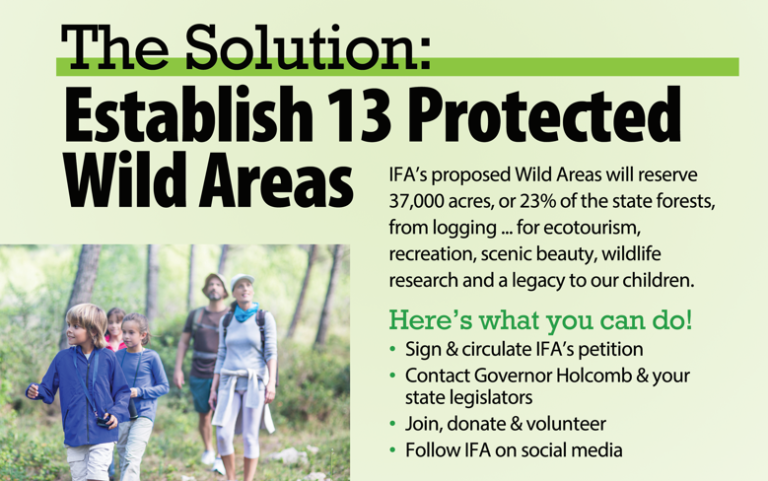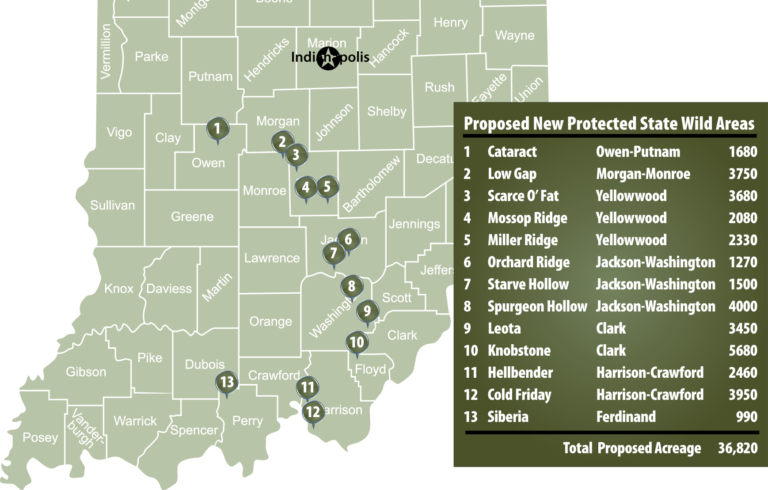Wild Indiana Campaign
Imagine 13 Wild Areas ...
Undisturbed Forests for All
Imagine 13 wild areas within seven Indiana State Forests: vast tracts of wild forest, undisturbed by commercial logging, perfect for hiking, backpacking, hunting, foraging, mountain biking, horseback riding, and camping.
These wild areas would also provide critical deep forest habitat for Indiana’s rare, threatened, and endangered species, including bobcats, gray foxes, bats, migratory songbirds, reptiles, and amphibians.
These state wild areas would comprise 36,820 acres, or 24%, of Indiana’s state forest acreage. With names like “Scarce O’ Fat” and “Hellbender,” the 13 areas are the most distinctive and intact areas in the whole state forest system.
The idea of creating 13 state wild areas is a modest proposal. Pennsylvania, for example, has designated 60 wild areas. The goal “To provide locations for scientific observation of natural systems, to protect examples of typical and unique plant and animal communities, and to protect outstanding examples of natural interest and beauty.”
In Indiana, a program of state wild areas would provide a place for recreating in wild nature that isn’t possible in a state nature preserve (off-limits to most recreation) or at state parks (heavily developed with roads, buildings, etc.). The Wild Indiana campaign’s objective is to restore a state forest management policy that balances timber production with recreation and wilderness preservation.
Click HERE to Read Our Letter to Gov. Eric Holcomb
About the Wild Indiana Campaign
The Campaign is a year-round effort to advance the issue with elected officials. And it is a vision that the IFA shared with Hoosiers around the state as we host events, table at festivals, and speak at meetings. The Wild Indiana campaign involves working with state legislators to pass laws that protect the state forests, and with Governor Holcomb. As the state’s chief executive over the Department of Natural Resources which manages our state forests, he has the authority to set aside areas of state forests.
Here’s What You Can Do!
- Read about the 13 wild areas and what makes them unique.
- Download and share a two-page description of the Wild Indiana Campaign.
- Learn more about the rationale for state wild areas in this white paper by Jeff Stant, IFA Executive Director.
- Join one of five coalitions around the state working locally to preserve these nearby wild areas: contact IFA for details.
- Communicate regularly with your state senator and representative—and Governor Holcomb–to express your support for legislation that sets aside some of Indiana’s public forests for future generations to enjoy them in their most primitive state.

The Wild Indiana Funders
The Indiana Forest Alliance’s Wild Indiana campaign is made possible with support from the following donors.
Where Are the 13 Wild Areas?

Map of proposed Wild Areas.
Get involved! Take action!
Indiana’s forests need you! Be part of an active, engaged network of forest advocates from all over Indiana. What can you do? Join IFA! Volunteer! Or write to or call officials on behalf of Indiana’s forests.
Home > Work > Protection > Wild Indiana Campaign
